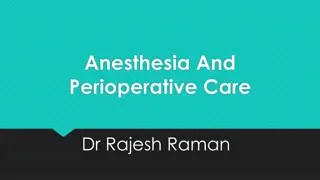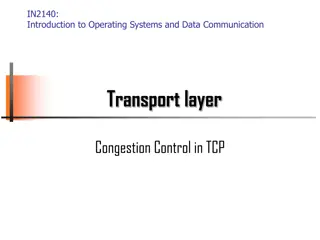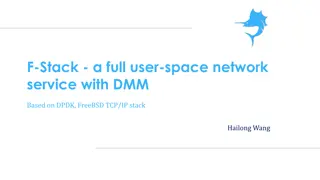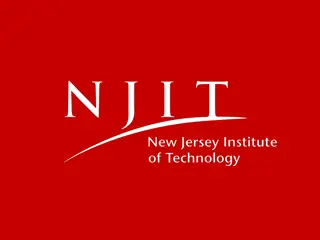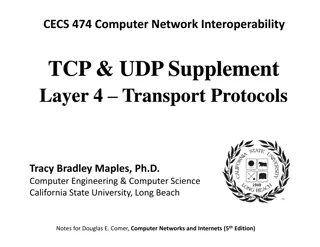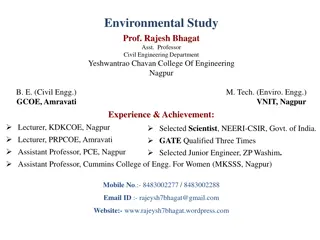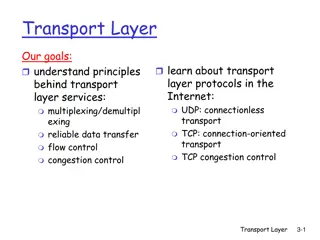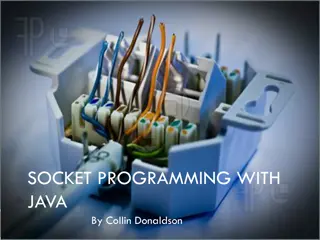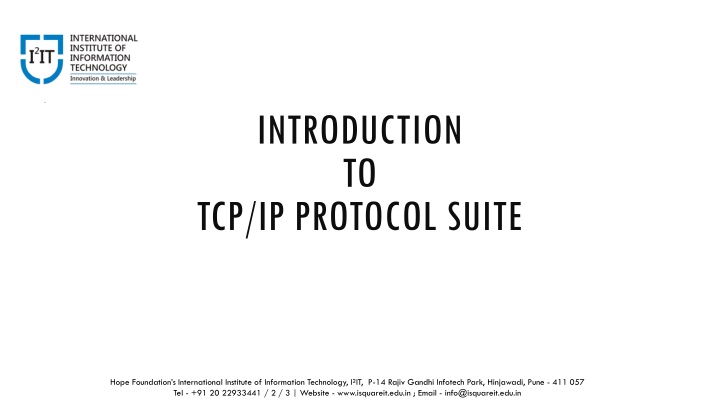
Protocol Layering & TCP/IP Suite | Introduction & Principles
Explore the concept of protocol layering in data communication and networking, highlighting the importance of protocols in effective communication. Learn about single-layer and three-layer protocols, along with the principles of protocol layering. Dive into the TCP/IP protocol suite used in the Internet, understanding its hierarchical structure and interactive modules. Enhance your knowledge of bidirectional communications and logical connections between peer layers.
Download Presentation

Please find below an Image/Link to download the presentation.
The content on the website is provided AS IS for your information and personal use only. It may not be sold, licensed, or shared on other websites without obtaining consent from the author. If you encounter any issues during the download, it is possible that the publisher has removed the file from their server.
You are allowed to download the files provided on this website for personal or commercial use, subject to the condition that they are used lawfully. All files are the property of their respective owners.
The content on the website is provided AS IS for your information and personal use only. It may not be sold, licensed, or shared on other websites without obtaining consent from the author.
E N D
Presentation Transcript
INTRODUCTION TO TCP/IP PROTOCOL SUITE Hope Foundation s International Institute of Information Technology, I IT, P-14 Rajiv Gandhi Infotech Park, Hinjawadi, Pune - 411 057 Tel - +91 20 22933441 / 2 / 3 | Website - www.isquareit.edu.in ; Email - info@isquareit.edu.in
PROTOCOL LAYERING In data communication and networking, a Protocol defines the rules that both the sender and receiver and all intermediate devices need to follow to be able to communicate effectively. When communication is simple, we may need only one simple protocol. When communication is complex, we may need to divide the task between different layers, in which case we need a protocol at each layer, or Protocol Layering. Source: Data Communications and Networking 5E, Forouzan Hope Foundation s International Institute of Information Technology, I IT, P-14 Rajiv Gandhi Infotech Park, Hinjawadi, Pune - 411 057 Tel - +91 20 22933441 / 2 / 3 | Website - www.isquareit.edu.in ; Email - info@isquareit.edu.in
A SINGLE LAYER PROTOCOL 1. Greet eachother when they meet 2. Confine the vocabulary to the level of friendship 3. Refrain from speaking if one is speaking 4. Opportunity to talk both on an issue (dialog / monolog) 5. Exchange nice words when departing Source: Data Communications and Networking 5E, Forouzan Hope Foundation s International Institute of Information Technology, I IT, P-14 Rajiv Gandhi Infotech Park, Hinjawadi, Pune - 411 057 Tel - +91 20 22933441 / 2 / 3 | Website - www.isquareit.edu.in ; Email - info@isquareit.edu.in
A THREE-LAYER PROTOCOL Source: Data Communications and Networking 5E, Forouzan Hope Foundation s International Institute of Information Technology, I IT, P-14 Rajiv Gandhi Infotech Park, Hinjawadi, Pune - 411 057 Tel - +91 20 22933441 / 2 / 3 | Website - www.isquareit.edu.in ; Email - info@isquareit.edu.in
PRINCIPLES OF PROTOCOL LAYERING First principle: If we want bidirectional communications, we need to make each layer so that it is able to perform two opposite tasks, one in each direction. Second Principle: Two objects under each layer at both side should be identical. Logical connection between peer layers Source: Data Communications and Networking 5E, Forouzan Hope Foundation s International Institute of Information Technology, I IT, P-14 Rajiv Gandhi Infotech Park, Hinjawadi, Pune - 411 057 Tel - +91 20 22933441 / 2 / 3 | Website - www.isquareit.edu.in ; Email - info@isquareit.edu.in
INTRODUCTION TCP/IP is a protocol suite used in the Internet today. It s a hierarchical protocol made up of interactive modules, each of which provides a specific functionality. Image Source: Weblink https://www.google.com/url?sa=i&so urce=images&cd=&ved=2ahUKEwjs poq34s7fAhVJbn0KHaFSBdMQjRx6B AgBEAU&url=https%3A%2F%2Fwww .youtube.com%2Fwatch%3Fv%3DS9 NhTS0WssI&psig=AOvVaw2rl2F6gu AkQrGI6I02i1PW&ust=154650720 2644930 Hope Foundation s International Institute of Information Technology, I IT, P-14 Rajiv Gandhi Infotech Park, Hinjawadi, Pune - 411 057 Tel - +91 20 22933441 / 2 / 3 | Website - www.isquareit.edu.in ; Email - info@isquareit.edu.in
COMMUNICATION THROUGH AN INTERNET Source: Data Communications and Networking 5E, Forouzan Hope Foundation s International Institute of Information Technology, I IT, P-14 Rajiv Gandhi Infotech Park, Hinjawadi, Pune - 411 057 Tel - +91 20 22933441 / 2 / 3 | Website - www.isquareit.edu.in ; Email - info@isquareit.edu.in
LAYERS IN THE TCP/IP PROTOCOL SUITE Source: Data Communications and Networking 5E, Forouzan Hope Foundation s International Institute of Information Technology, I IT, P-14 Rajiv Gandhi Infotech Park, Hinjawadi, Pune - 411 057 Tel - +91 20 22933441 / 2 / 3 | Website - www.isquareit.edu.in ; Email - info@isquareit.edu.in
IDENTICAL OBJECTS IN THE TCP/IP PROTOCOL SUITE Source: Data Communications and Networking 5E, Forouzan Hope Foundation s International Institute of Information Technology, I IT, P-14 Rajiv Gandhi Infotech Park, Hinjawadi, Pune - 411 057 Tel - +91 20 22933441 / 2 / 3 | Website - www.isquareit.edu.in ; Email - info@isquareit.edu.in
PHYSICAL LAYER Physical layer is responsible for movements of bits from one hop(node) to the next 1. Physical Characteristics of Interface and medium : Type of Transmission medium 2. Representation of Bits : Encoding Techniques ; Conversion of Bits to Electrical/Optical signals 3. Data rate: bits/sec 4. Synchronization: Clock Synchronization at Sender & receiver 5. Physical Topology: Star, Bus, Mesh, Ring etc 6. Line Configuration : Point to Point, Multipoint Configurations 7. Transmission Mode : Simplex , Half-Duplex, Full-Duplex Image Source: https://slideplayer.com/slide/9415506/ Source: Data Communications and Networking 5E, Forouzan Hope Foundation s International Institute of Information Technology, I IT, P-14 Rajiv Gandhi Infotech Park, Hinjawadi, Pune - 411 057 Tel - +91 20 22933441 / 2 / 3 | Website - www.isquareit.edu.in ; Email - info@isquareit.edu.in
DATA LINK LAYER Data link layer is responsible for moving frames from one hop(node) to the next Image Source: http://www.highteck.net/EN/DataLink/Data_Link_Layer.html 1. Framing 2. Physical Addressing 3.Flow control 4. Error Control: Detection & Correction 5. Access Control e.g., ARP, IEEE 802.3 and IEEE 802.11 Source: Data Communications and Networking 5E, Forouzan Hope Foundation s International Institute of Information Technology, I IT, P-14 Rajiv Gandhi Infotech Park, Hinjawadi, Pune - 411 057 Tel - +91 20 22933441 / 2 / 3 | Website - www.isquareit.edu.in ; Email - info@isquareit.edu.in
NETWORK LAYER Network layer is responsible for delivery of individual packets from source host to destination host 1. Logical Addressing: IPv4, IPv6 2. Routing: Routing algorithms & table (traffic routing & control) e.g., IP, ICMP, IGMP, DHCP Image Source: Weblink https://fossbytes.com/network-layer- osi-model/ Source: Data Communications and Networking 5E, Forouzan Hope Foundation s International Institute of Information Technology, I IT, P-14 Rajiv Gandhi Infotech Park, Hinjawadi, Pune - 411 057 Tel - +91 20 22933441 / 2 / 3 | Website - www.isquareit.edu.in ; Email - info@isquareit.edu.in
TRANSPORT LAYER Transport layer is responsible for the delivery of the message from one process to another 1. Service point addressing: Port Address 2. Segmentation : Divided into transmittable segments with sequence numbers 3. Connection Control 4. Flow Control 5. Session Multiplexing 6. Error Detection & Correction (resends) 7. Message reordering (reassembly) e.g., TCP, UDP Source: Data Communications and Networking 5E, Forouzan Hope Foundation s International Institute of Information Technology, I IT, P-14 Rajiv Gandhi Infotech Park, Hinjawadi, Pune - 411 057 Tel - +91 20 22933441 / 2 / 3 | Website - www.isquareit.edu.in ; Email - info@isquareit.edu.in
APPLICATION LAYER Application layer is responsible for providing services to the user. 1. Network virtual terminal (e.g. usgs) 2.File transfer, access and management 3.Mail services 4.Directory services Source: Data Communications and Networking 5E, Forouzan Image Socure: https://www.pinterest.com/pin/561050066049773076/?lp=true Hope Foundation s International Institute of Information Technology, I IT, P-14 Rajiv Gandhi Infotech Park, Hinjawadi, Pune - 411 057 Tel - +91 20 22933441 / 2 / 3 | Website - www.isquareit.edu.in ; Email - info@isquareit.edu.in
Source: Data Communications and Networking 5E, Forouzan Hope Foundation s International Institute of Information Technology, I IT, P-14 Rajiv Gandhi Infotech Park, Hinjawadi, Pune - 411 057 Tel - +91 20 22933441 / 2 / 3 | Website - www.isquareit.edu.in ; Email - info@isquareit.edu.in
Specific Address Relationship of layers and Addresses in TCP/IP Image Source : https://slideplayer.com/slide/5357044/ Hope Foundation s International Institute of Information Technology, I IT, P-14 Rajiv Gandhi Infotech Park, Hinjawadi, Pune - 411 057 Tel - +91 20 22933441 / 2 / 3 | Website - www.isquareit.edu.in ; Email - info@isquareit.edu.in
Thank you very much Hope Foundation s International Institute of Information Technology, I IT, P-14 Rajiv Gandhi Infotech Park, Hinjawadi, Pune - 411 057 Tel - +91 20 22933441 / 2 / 3 | Website - www.isquareit.edu.in ; Email - info@isquareit.edu.in



